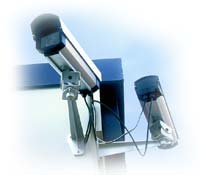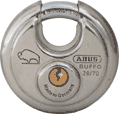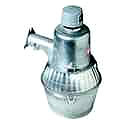|
How Safe is
"State-of-the-Art" Security?
 Exactly what "state of the art" means is mystifying
to most of us, since everybody uses it to describe
everything they make now.
Exactly what "state of the art" means is mystifying
to most of us, since everybody uses it to describe
everything they make now.
Taken literally it should mean something that was
invented two hours before the alarm went off this morning, and
is the highest-of-the-high-tech-marvels known to man.
Just because it was announced today, however, means
nothing. It could be a cheap knockoff of something that
truly is "state of the art."
A few specifics in plain English would help.
Herewith we present some 24-carat examples of high-tech
security and the questions you should ask before reaching
for your credit card.
Security
Check #1
What
is it about your perimeter
fence
that keeps
out intruders?
 First, scratch from your list facilities that
don't have a perimeter fence. Chances are you won't like much
else about them either. Now for those that do. Get the manager
to explain precisely what it is in the design and construction
of his fence that deters intruders. Is it wired so that an
alarm goes off? Is it so tall it takes a crane to get over? Is
it so stout that an intruder couldn't easily get through with
industrial gauge chain hitched to a pickup? Has anyone ever
broken through since the business was opened? How is that, why
is this? There's no such thing as too many qualifiers when it
comes to sizing up how effective a facility is in convincing
would-be intruders they'd be better off going somewhere else. First, scratch from your list facilities that
don't have a perimeter fence. Chances are you won't like much
else about them either. Now for those that do. Get the manager
to explain precisely what it is in the design and construction
of his fence that deters intruders. Is it wired so that an
alarm goes off? Is it so tall it takes a crane to get over? Is
it so stout that an intruder couldn't easily get through with
industrial gauge chain hitched to a pickup? Has anyone ever
broken through since the business was opened? How is that, why
is this? There's no such thing as too many qualifiers when it
comes to sizing up how effective a facility is in convincing
would-be intruders they'd be better off going somewhere else.
Security
Check #2
How effectively
does that entrance
gate
screen out the people we don't want in?
 What
type of gate controller does the property have? The vast
majority of the facilities use a keypad for entering and
exiting. Each tenant is given his or her individual code that
allows access. Every time you enter and leave using the
keypad, you leave a record of the time entered, duration of
stay, and the time you left. Some properties have a keypad for
entry but not for exit which will not track the time you spent
on the property. What
type of gate controller does the property have? The vast
majority of the facilities use a keypad for entering and
exiting. Each tenant is given his or her individual code that
allows access. Every time you enter and leave using the
keypad, you leave a record of the time entered, duration of
stay, and the time you left. Some properties have a keypad for
entry but not for exit which will not track the time you spent
on the property.
Security Check #3
 It seems every self storage facility
promotes
the advantage of
video cameras. What
will It seems every self storage facility
promotes
the advantage of
video cameras. What
will
yours do that others won't?
Many
facilities today use closed circuit television (CCTV) to not
only provide 24-hour surveillance, but to use as a marketing
advantage over the properties that do not. However, this may
increase the rental rates a few dollars. Take note of the
camera locations as compared to the unit you have selected to
see that you are in the viewing, if not, you may want to
request a different location. Most facilities provide
surveillance tape for thirty days and then it is reused; if
the interval is shorter, it may not provide the desired
security.
Security
Check #4
I hear that good locks can make a
difference,
but any lock can be broken.
How will I know
when I've got enough?
 Most perpetrators will not spend more than a couple of minutes
trying to remove a lock from a door. Therefore many locks are
now rated on how long they can endure assault. They range from
Class 1 which lasts one minute, to Class 5 at five minutes.
Terrific, but what about bolt cutters? The lock that could
foil that probably doesn't exist yet. Behold the disk lock.
This is a round lock that would give King Kong fits. It's
secret is that its circular design limits the shackle’s
exposure so that bolt cutters will have a dickens of a time
finding a notch to clamp down on. It costs more, yes, but it's
worth it. Most perpetrators will not spend more than a couple of minutes
trying to remove a lock from a door. Therefore many locks are
now rated on how long they can endure assault. They range from
Class 1 which lasts one minute, to Class 5 at five minutes.
Terrific, but what about bolt cutters? The lock that could
foil that probably doesn't exist yet. Behold the disk lock.
This is a round lock that would give King Kong fits. It's
secret is that its circular design limits the shackle’s
exposure so that bolt cutters will have a dickens of a time
finding a notch to clamp down on. It costs more, yes, but it's
worth it.
Security Check #5
What is it about your lighting that
should make
me feel safe when coming in
at night?
 Lighting can be critical if you will need to access the
facility at night. Drive by the facility on your way home some
night to see how well it is lighted. If the property has
indoor corridors, ask how the lights work. Some are on
timers that allow a limited amount of time. If there's any
doubt that the lighting isn't sufficient for your unit's
location, ask to be relocated. Lighting can be critical if you will need to access the
facility at night. Drive by the facility on your way home some
night to see how well it is lighted. If the property has
indoor corridors, ask how the lights work. Some are on
timers that allow a limited amount of time. If there's any
doubt that the lighting isn't sufficient for your unit's
location, ask to be relocated.
|